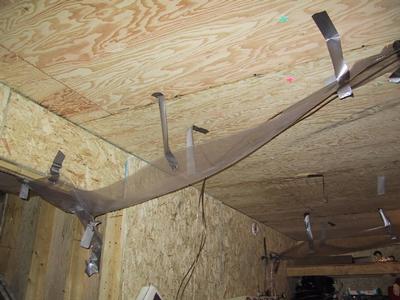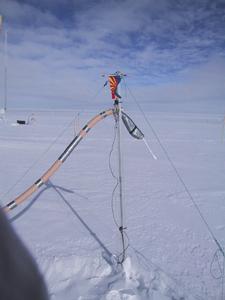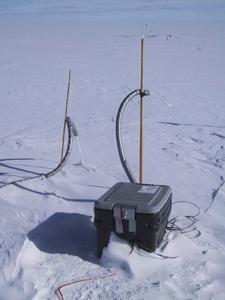
|
27 July, 2001Catching clues - more about the parallel experiments What is the relationship between the atmosphere and the snowpack? In order to have a better picture of how these two systems work together, Markus has designed a suite of simultaneous parallel experiments to catch the pattern of flux between the gases in the air and the snow. Theoretically, the snow traps atmospheric gases as snowflakes are deposited, but during the day when temperatures are higher and the sun’s radiation stronger some of these gases are transformed in the snow or released from the snow back into the atmosphere. One can think of the snow - atmosphere system as a column that the gases move up and down in. In order to quantify and explain this system it is necessary to observe the gases in the entire column simultaneously. Last night, in the freezing cold, Markus and I set up his “ mouse elevator”. This device allows Markus to sample atmospheric gases at several elevations each hour. This is the final instrument to complete the puzzle of our parallel experiments. At the moment, we are sampling and observing using the techniques listed below. A.The snow. Snow samples -- I collect between 50 and 200 of these a day. The location, timing and pattern of collection vary with the experiment. On clear calm days it is best to catch the snow at a variety of times. This also coordinates with Markus’ gradient investigation. When the weather is less stable I vary the locations of the snow sampling to include spacial variations. I have also looked for unique snow structures such as sastrugis (snow drifts and bumps in the snow). We are also trying to catch fresh snow whenever it falls. To accomplish this, I set up bottles in the snow and hope the flakes fall in. For more details see the snow story B. The sublimation and deposition rate. This is the petri dish or lysimeter experiment. I have set up 8 petri dishes and am recording their masses 3 times a day. On a still day there should be a loss of mass, indicating sublimation. When we have snow or still night with fog the mass increases indicating deposition. This piece of the project is finally going well. I have been able to observe changes in mass in the dishes. For more details see parallel experiments C. The atmospheric gases at a constant height 1 meter above the snow Markus and Manuel maintain one air intake line at a constant height of approximately 1 meter above the snow. This air intake leads to the DNPH cartridges which collect formaldehyde. D. The gradient of atmospheric gases This experiment uses the “mouse elevator”. The mouse elevator is called this because the lift for the air intake tube looks like a mini elevator, just the right size of for a mouse. Markus has programmed the elevator to move up and down between 5 and 110 centimeters every ten minutes. This allows him to examine the gradient or change in concentrations of gases at different heights above the snow. During a daily cycle the concentrations of gases in the air will change with changes in the temperature and photo chemistry. This experiment works best during a period of calm still air. E. The firn air One of the probes Markus uses to sample air is set ten centimeters below the surface of the snow. Using this probe, Markus is drawing a constant flow of air from the top layer of snow, called the firn. This probe set up is also used during the shading experiments which examine whether the UV rays from the sun effect the gases stored in and released from the snow. Mary Albert, Jack Dibb and Aaron Swanson are also parcticipating in these firn air experiments. They include experiments that use tracer gases to detect where and how the atmospheric air is traveling through the firn layer. F. The temperature profile. In order to correlate the relationship between temperature and snow chemistry, Markus has buried sixteen temperature probes in the walls of a closed snow pit down to 160 centimeters. The sunlight warms the top layers of the snow down to about thirty centimeters during the daytime. This layer of snow is the most chemically active. G. Hoar frost, rime and fog These are the missing pieces of the previous data collected on this topic at Summit. We are hoping to catch the ice fog that rolls in here most nights. This fog frost contains high quantities of H202. It forms on the ropes and poles in the camp. It also forms on the snow in a kind of reverse sublimation process. The frost only deposits on still nights. We will set up a series of lines of Teflon rope to catch the frost at different heights above the snow. H. The weather Whenever we collect any other data we also make weather observations. Weather data is also being collected in great detail by the Swiss team. We record cloud cover, temperature, wind speed and direction, and precipitation. There are many types of precipitation here including; snow, ice crystals and fog. The winds mix the air and make it more difficult to measure the gradient of chemicals. Clouds change the amount of radiation entering the system and can trap heat closer to the earth. They also make it more difficult to do shading experiments because they can diffuse or scatter the light rays. The Swiss are also collecting radiation data and are tracking the thickness of the ozone column above the camp. Ozone blocks the UV radiation. The ozone over Summit is thinner than some other places on earth. Knowing the radiation or energy balance is an important part of the equation when modeling the behavior of the atmosphere.
Contact the TEA in the field at . If you cannot connect through your browser, copy the TEA's e-mail address in the "To:" line of your favorite e-mail package. |







